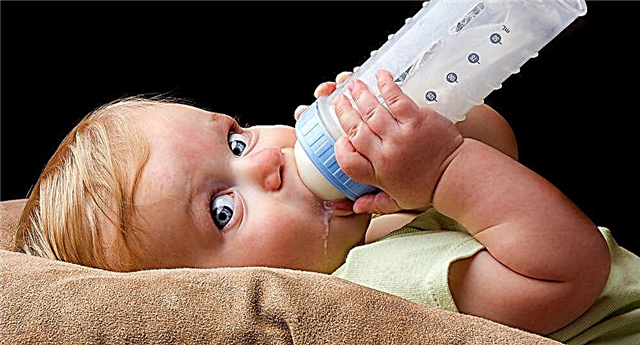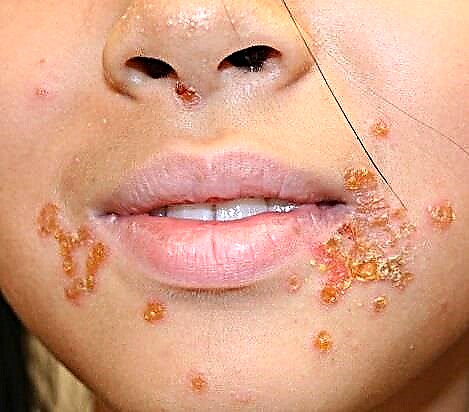
Rashes on healthy skin in a baby are often the result of some pathology in the child's body. A rash all over the body can appear in a baby without a high body temperature. This article describes in what situations this situation arises and how to help the baby.
Causes of occurrence
Various causative factors can cause the appearance of various rashes on the skin. The severity of the manifestation of clinical symptoms is different. Infant babies can tolerate the disease somewhat more severely than older children. Also, in most cases, rashes on their skin become generalized, that is, they cover almost the entire body.
Doctors identify several clinical variants of rashes that appear on the skin of babies even in the absence of a high temperature. So, in newborn babies, a rash on the skin may have quite physiological character.
Such rashes appear in a child due to the imperfect work of the endocrine system and a periodic increase in the level of hormones. This condition is completely temporary and disappears as the child grows.
Immunological reasons lead to the fact that various rashes begin to appear on the baby's skin. These include:
- irritating chemicals;
- provoking allergens of various origins;
- exposure to external factors (high ambient temperature, low humidity, intense exposure to ultraviolet rays, and others);
- mechanical pressure or friction.
These reasons lead to the activation of immune cells, which are normally located in the layers of the skin and are necessary to protect the child's body from various infections. Activated cells begin to fight allergens, which is manifested in the development of the baby immune inflammation. This condition can occur with both high and low body temperature.
An immune rash in most cases is accompanied by severe itching. This feature is due to the activation of special immune cells, which emit a huge amount of biologically active substances that irritate the skin. This condition leads to the fact that the child begins to strongly scratch the damaged skin.

Various rashes also contribute to the appearance on clean skin of the baby multiple bacterial or viral diseases. They, as a rule, are easily transmitted from a sick child to a healthy one. Children attending kindergarten or school, according to statistics, fall ill with such infectious pathologies several times more often.
Infections often occur with an increase in body temperature. However, this is not always the case. In some babies, body temperature may be low or even remain within normal limits.


Many viral and bacterial infections also cause the baby to develop and other adverse symptoms, and not only the appearance of pathological rashes on the skin:
- A sick baby may experience soreness in the abdomen, general weakness, headache and fatigue.
- Young babies often develop various stool disorders, which are manifested as persistent constipation and diarrhea.
- A sick baby's appetite is significantly reduced. Babies may even refuse breastfeeding or poorly attach to the mother's breast.
- The sick child's behavior also changes. Such a baby becomes more withdrawn and nervous. He tries to avoid any active games.
- The child's sleep is also significantly disturbed. The baby, as a rule, experiences severe daytime sleepiness, and wakes up many times at night.
- The course of this condition can be significantly hampered by the appearance of itchy skin in the child.
What does it look like?
Skin rashes that appear in a child against a background of normal body temperature can manifest themselves in different ways.
Allergy
An allergic rash is usually small and red. The diameter of such skin rashes in most cases does not exceed 5-6 mm. Such red spots quite often merge with each other, forming elements with irregular or bizarre edges.
Skin with an allergic rash usually itches a lot... Pathological rashes can appear on almost all parts of the body. With contact dermatitis, loose elements appear only in places of direct exposure to the allergen.
They usually look like multiple bright red spots that itch a lot and cause the child a lot of discomfort.


Bacterial infections
Some forms of bacterial infections are manifested by the appearance of not only a red rash on the skin, but also the appearance of multiple blisters. There is a bloody fluid inside such formations.
The outer wall of these skin vesicles is quite thin and can easily be injured when touched. This leads to the fact that all the liquid flows out.
The peak of infectious diseases in babies usually occurs at age 2-5 years... At this time, the work of the immune system is not yet sufficiently formed, which leads to the fact that the child can easily become infected with any infection.


Prickly heat
The appearance of bright red spots behind the ears may indicate that the baby has prickly heat. This condition most often develops in infants and is associated with excessive wrapping of babies. Wearing a woolen hat that is too warm can cause your baby to have symptoms of prickly heat on the neck and face.


Hormone imbalance
The appearance of abscesses on the skin of the back is quite often a manifestation of an imbalanced hormone balance. The development of this pathological condition, as a rule, leads to an increased level of testosterone.
Pustular rashes usually appear on the back, shoulders, face, and also on the upper half of the body. This condition develops more often in adolescence.


Where to contact?
The appearance of rashes on the skin is a mandatory reason for parents to show their child to a doctor. For the first visit, it is enough to consult a pediatrician... This doctor will conduct the necessary clinical examination and establish a presumptive diagnosis.
If the differential diagnosis is rather complicated and requires special knowledge about skin diseases, then the pediatrician will refer the baby to a pediatric dermatologist for consultation.


To establish the correct diagnosis, all babies undergo a whole range of different studies.
A general blood test allows you to detect even hidden signs of various infectious pathologies, and also gives doctors an idea of the severity of functional disorders. Even in the absence of a high body temperature, the child's leukocytes and ESR may be increased. These laboratory changes clearly indicate that certain pathologies develop in the child's body.


In some cases, it is possible to identify the causative agent of the disease only with the help of special bacteriological studies.
These methods include scraping... The biological material for this test is the upper layers of the skin. They are taken for research by a nurse in the laboratory, and in some cases only by a pediatric dermatologist. The readiness of the material is usually 3-5 days from the moment of taking the material.
To identify and differentiate various forms of allergic diseases, various allergy tests. They make it possible to establish whether a child has individual hypersensitivity to certain types of allergens. This test is performed only by an immunologist.
Such a study gives doctors a fairly complete picture of which allergens a child has a strong sensitivity to.


How is the treatment carried out?
After establishing the diagnosis, doctors prescribe complex therapy to the sick baby. It can include a wide variety of drug combinations. The main goal of such treatment is to cleanse the skin from rashes and strengthen local immunity.
The selection of medicines is carried out taking into account the main cause of the disease, which caused the appearance of such adverse skin manifestations in the child. To eliminate an allergic rash, drugs are used that contain in their composition antihistamines. Such funds not only cope with rashes, but also help to reduce itching.
To achieve the result, it usually takes at least 7-10 days of taking these drugs. The first positive effect, as a rule, is noticeable as early as 2-3 days from the beginning of the use of drugs.

Antihistamines can come in various forms. With a mild course of a pathological condition, it is enough to use special ointments or creams. Such funds are perfectly distributed over the skin, are quickly absorbed and penetrate well into all skin layers. These medicines include: "Gistan N", "Fenistil gel" and many others. Such drugs should be used in accordance with the instructions on the package.
With systemic spread of skin elements, only local treatment is not enough. In this case, doctors recommend using tablet forms medicines. These drugs include: "Suprastin", "Loratadin", "Zirtek" and many others. They are prescribed 1-2 times a day, mainly in the first half of the day.
If a red rash on the child's skin appears as a result of overheating of the child, then parents should definitely review the clothes they use for the baby. Do not over-wrap your child. For walks on the street, you should give preference to rather warm, but at the same time "breathable" clothing.
For babies, especially the first years of life, it is better to choose blouses or pants made from natural materials.


Red rashes that appear in babies in various parts of the body can also be triggered various cosmetic products, which are used for daily hygiene procedures.
Mothers should pay particular attention to body lotions and creams. Quite often, their composition includes various chemical fragrances and dyes, which cause the appearance of various allergic rashes on the delicate skin of a child.
Babies who have a tendency to develop skin forms of allergies should choose cosmetics that do not contain any aggressive components.
It is better to limit the use of all products having a strong odor. Preference should be given to children's cosmetics, which are approved for use in newborn babies and have all the necessary certificates of quality and safety.


The same attention should be paid to selection of household chemicalsused for washing baby clothes. Unscrupulous manufacturers add rather aggressive surfactants to such products to enhance the detergent and detergent properties. Once on the skin, these chemicals can trigger a bright red rash in your baby.
You should also choose children's detergents quite carefully, be sure to monitor how the child's skin reacts to contact with clothes washed in them.

The use of antibiotics plays an important role in the treatment of bacterial infections. They can be prescribed for 3 to 10 days. A longer intake is possible only if the child has a rather severe course of the disease.
Selection of the necessary antibiotic, its course dosage and duration of treatment determined by the attending physician. To eliminate adverse symptoms, drugs are currently mainly used that have a rather wide range of actions.

If the baby has a tendency to the appearance of any rashes on the skin, then doctors recommend using special creams with anti-inflammatory effect... Such drugs not only relieve inflammation, but also have a fairly good moisturizing effect on the skin.
Using "Bepantena" can reduce various irritations on the skin of babies. This product should be used after hygiene procedures.


In some clinical situations, doctors recommend reduce the duration of the baby's bathing. Children with atopic dermatitis should not have long baths. This can only lead to excessive dryness of the skin, which will contribute to additional trauma to the skin and massive spread of rashes on it.
After bathing the baby, you should not strongly wipe the skin with a towel, just dab excess moisture from them a little.

A proper diet is an important basis for maintaining healthy skin. For babies in the first months of life, nature has come up with a unique food - mother's milk. This biological product contains all the necessary vitamins and microelements, as well as food nutrients that can prevent many skin pathologies in babies.
Older children should get enough quality protein. This is necessary for the full functioning of their immune system.

Manufactured sweets and chocolates should be kept as short as possible in the children's menu. The frequent inclusion of such "sweets" in the diet only contributes to the appearance of various rashes on the skin, including those of allergic origin.
Dr. Komarovsky will tell you all about rashes in children in the next video.



